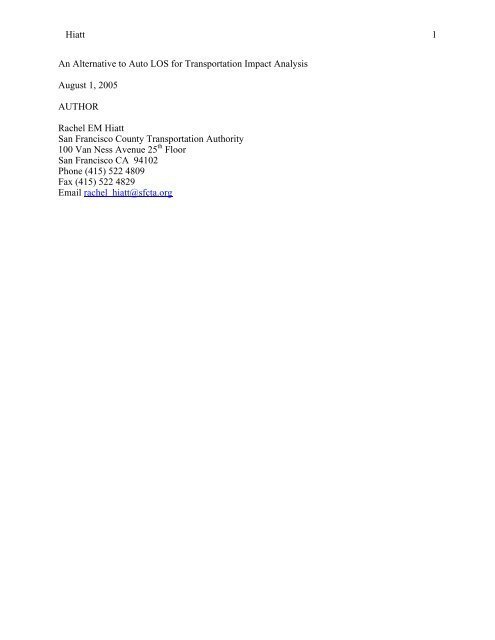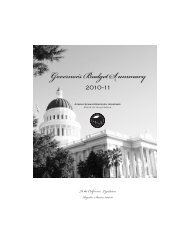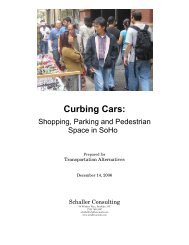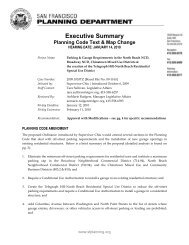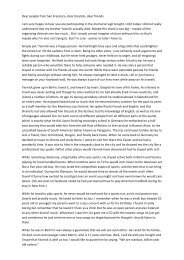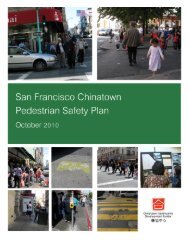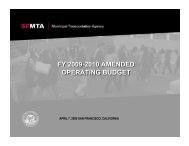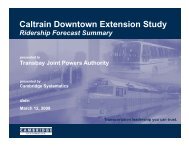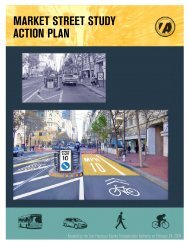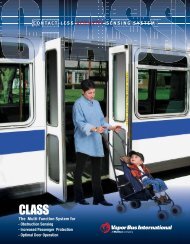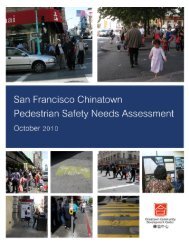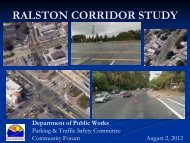Alternatives To Auto LOS For Impact Analysis 111505
Alternatives To Auto LOS For Impact Analysis 111505
Alternatives To Auto LOS For Impact Analysis 111505
You also want an ePaper? Increase the reach of your titles
YUMPU automatically turns print PDFs into web optimized ePapers that Google loves.
Hiatt 1<br />
An Alternative to <strong>Auto</strong> <strong>LOS</strong> for Transportation <strong>Impact</strong> <strong>Analysis</strong><br />
August 1, 2005<br />
AUTHOR<br />
Rachel EM Hiatt<br />
San Francisco County Transportation Authority<br />
100 Van Ness Avenue 25 th Floor<br />
San Francisco CA 94102<br />
Phone (415) 522 4809<br />
Fax (415) 522 4829<br />
Email rachel_hiatt@sfcta.org
Hiatt 2<br />
An Alternative to <strong>Auto</strong> <strong>LOS</strong> for Transportation <strong>Impact</strong> <strong>Analysis</strong><br />
ABSTRACT<br />
<strong>Auto</strong>mobile Level of Service (<strong>LOS</strong>) standards are the measure of the adequacy of<br />
roadways to serve vehicle demand. Increasingly, research is published on alternatives to<br />
conventional automobile <strong>LOS</strong>. Practicing transportation planners have also shown increasing<br />
interest in applying these alternative tools, particularly in urban locations encouraging<br />
multimodal transportation systems or infill development. Much of the research and activity on<br />
alternatives to auto <strong>LOS</strong> has focused on two approaches: 1) creating transportation performance<br />
measures to complement auto <strong>LOS</strong>, such as “user based” <strong>LOS</strong> measures for transit, bicycling,<br />
and walking; and 2) applying conventional auto <strong>LOS</strong> standards more flexibly. Neither approach<br />
is likely to effectively address the shortcomings of auto <strong>LOS</strong> as the measure of transportation<br />
impact in urban, multimodal contexts. The approaches are particularly unlikely to be effective<br />
where state law requires formal standards for transportation facilities and significant public and<br />
private sector resources have been dedicated to achieving auto <strong>LOS</strong> conformity. This paper<br />
presents an alternative to auto <strong>LOS</strong> for environmental impact analysis purposes under<br />
investigation by the San Francisco County Transportation Authority, developed to support the<br />
transportation system development objectives of an urban, multimodal context, and to respond<br />
specifically to the legal requirements and constraints of California’s environmental impact<br />
analysis requirements. Local jurisdictions with similar situations, such as urban areas with<br />
growth management, concurrency management, or public facilities requirements, may find these<br />
alternatives more effective than the user-based measures and flexible auto <strong>LOS</strong> applications most<br />
frequently discussed in the literature.
Hiatt 3<br />
BACKGROUND<br />
What is Level of Service?<br />
<strong>Auto</strong>mobile Level-of-Service (<strong>LOS</strong>) is a conventional traffic engineering tool that quantifies the<br />
ability of roads and freeways to serve traffic demand. <strong>LOS</strong>, most recently set forth in the 2000<br />
Highway Capacity Manual (HCM) (1), is the most widely used measure of transportation facility<br />
performance (2).<br />
The first HCM introduced <strong>LOS</strong> measures during the development of the Interstate<br />
Highway System in the 1950s (3). The current (2000) approach to <strong>LOS</strong> is based on the 1985<br />
HCM or the Transportation Research Circular 212, “Interim Materials on Highway Capacity.”<br />
(4). These methodologies estimate <strong>LOS</strong> for intersections or roadway segments based on the ratio<br />
of vehicle demand to capacity of the roadway (V/C ratio), or on the average seconds of delay to<br />
vehicles at intersections (5).<br />
<strong>LOS</strong> is popular because it is widely professionally accepted, the data required to calculate<br />
it are easily available, and the concept offers discrete standards (letters A – F) for “grading” the<br />
performance of a transportation facility.<br />
The Statutory Review Context<br />
<strong>LOS</strong> is applied to describe and evaluate the actual performance of freeways, roadway links, or<br />
intersections, and when travel forecasts are available, to predict the future performance of those<br />
transportation facilities given changes in development patterns, traffic capacity, or other factors<br />
which affect travel demand. <strong>LOS</strong> is used to comply with state and local laws requiring local<br />
governments to evaluate the expected traffic impacts of proposed developments projects on the<br />
transportation system and inform development project approvals. These laws include<br />
environmental impact assessment; concurrency and growth management; and adequate public<br />
facilities management (3). In many cases, local governments set legally binding standards for<br />
transportation performance in terms of <strong>LOS</strong>. This paper addresses statutory contexts where<br />
<strong>LOS</strong> has been required by state law or has a long, legally established statewide precedent,<br />
because these are the situations where adopting an alternative standard to <strong>LOS</strong> is more difficult.<br />
Environmental <strong>Impact</strong> Assessment<br />
The California Environmental Quality Act (CEQA) requires that local jurisdictions disclose any<br />
negative impacts that proposed projects may have on the environment, including the<br />
transportation environment. <strong>To</strong> comply with CEQA local governments must identify how<br />
impacts to transportation are measured, and define a threshold at which impacts to transportation<br />
are considered significant environmental impacts. Projects with potential impacts on the<br />
environment cannot be approved unless the project sponsor undertakes a variety of actions<br />
depending on the nature of the impact, such as preparing an Environmental <strong>Impact</strong> Reports and<br />
implementing measures to mitigate the negative impacts (6).<br />
Concurrency management, growth management, and adequate public facilities ordinances.<br />
These laws limit the development that a local jurisdiction may approve, based on the availability<br />
of public infrastructure and services (including transportation infrastructure) to serve that<br />
development. The availability of transportation infrastructure is typically assessed using <strong>LOS</strong>.<br />
<strong>For</strong> instance, growth management acts in Florida (1985) (7) and Washington state (1990)<br />
(8) require local jurisdictions to set service level standards for transportation facilities, and also<br />
mandate that they deny development permits that would results in conditions exceeding these
Hiatt 4<br />
adopted standards. Local governments adopt these <strong>LOS</strong> standards as part of their local<br />
comprehensive plans, and incorporate them in local capital improvements plans. Local<br />
jurisdictions must deny development proposals that are expected to cause declines in <strong>LOS</strong> on<br />
below the adopted standards, unless transportation improvements or strategies to accommodate<br />
the impacts of development are made concurrent with the development (9).<br />
The State of Maryland has enabled cities and counties to adopt Adequate Public Facilities<br />
Ordinances (APFOs), in order to prevent new development projects until adequate transportation<br />
infrastructure capacity is available to accommodate the added trips (10). <strong>LOS</strong> standards are<br />
established for determining the adequacy of transportation infrastructure to accommodate<br />
development. No development project can be approved by the city if <strong>LOS</strong> on the transportation<br />
infrastructure will drop below this <strong>LOS</strong> (11).<br />
The state of California also requires, through the 1990 Congestion Management statutes,<br />
urbanized counties to set and monitor service level standards for major highways and arterials.<br />
When <strong>LOS</strong> on any congestion management roadway falls below the adopted standard, a<br />
countywide Congestion Management Agency is responsible for developing a deficiency plan to<br />
return the roadway to the adopted <strong>LOS</strong> (12). However, congestion Management in California<br />
has no direct link to the development approvals process, however, and thus does not have as far<br />
reaching implications for the allocation and expenditure of public and private resources.<br />
Level of Service Standards for Environmental Review in San Francisco<br />
Pursuant to CEQA, San Francisco uses auto <strong>LOS</strong> to estimate the environmental significance of<br />
impacts from proposed projects on the transportation system (13).<br />
The expected impacts of proposed projects on transit, bicycling, and walking are also<br />
evaluated to varying extents. San Francisco currently defines transportation impact with distinct<br />
measures for each mode, some more clearly defined than others. The city’s measure of transit<br />
<strong>LOS</strong> compares the capacity of one or more transit lines in the vicinity of a proposed project with<br />
the projected transit demand for that direction of travel. Called the “load factor,” this is an<br />
aggregate measure of crowding on transit vehicles at a point of the network.<br />
Pedestrian <strong>LOS</strong> is evaluated using a similar “crowding” measure that estimates he<br />
amount of usable sidewalk space per pedestrian, and is supplemented by a qualitative evaluation<br />
of safety impacts measured according to unpublished criteria. Bicycle <strong>LOS</strong> is assessed either<br />
qualitatively or with a “crowding” measure (amount of dedicated bicycle space per bicyclist).<br />
SHORTCOMINGS OF AUTO <strong>LOS</strong> AS STANDARD FOR TRANSPORTATION<br />
IMPACT IN THE URBAN, MULTIMODAL CONTEXT<br />
Increasingly, local jurisdictions seek alternatives to auto <strong>LOS</strong> as the adequacy standard for<br />
transportation. <strong>Auto</strong> <strong>LOS</strong> standards are particularly shortsighted for cities with multimodal<br />
transportation systems. Using auto <strong>LOS</strong> as the legal standard for transportation system adequacy<br />
to support new development has three general consequences that may be inconsistent with urban<br />
infill development and multimodal transportation system development. An <strong>LOS</strong> standard is<br />
likely to:<br />
1) Reinforce the use of public right-of-way for moving cars, and discourage the<br />
development of transit, bicycle, and pedestrian improvement projects where they will increase<br />
delay for cars;<br />
2) Increase the costs in time and money for implementing transit, bicycle, and pedestrian<br />
projects; and<br />
3) Hinder a city’s ability to advance other local policies such as promoting infill<br />
development and mode shift to transit, bicycling, and walking.
Hiatt 5<br />
Though auto <strong>LOS</strong> provides valuable information for planning purposes, it does not meet<br />
the needs of urban multimodal areas when used as a legal standard to define the adequacy of<br />
transportation facilities.<br />
Reinforcing the Incumbent Mode<br />
Strict standards for auto <strong>LOS</strong> can make infill development and improvements to modes other<br />
than the auto difficult, particularly on mature street networks where roadway space is<br />
constrained. San Francisco’s next generation of transportation improvements to transit,<br />
pedestrian, and bicycle facilities will require reallocating roadway space from mixed traffic uses<br />
to pedestrian, bicycle, or transit use, sometimes worsening auto <strong>LOS</strong> (14). Consequently, using<br />
auto <strong>LOS</strong> as the standard for roadway adequacy ostensibly favors preserving auto <strong>LOS</strong> at the<br />
expense of improvements to transit, bicycle, and pedestrian conditions.<br />
Discouraging Multimodal Improvements<br />
In San Francisco, a proposed project with impacts forecast to worsen <strong>LOS</strong> to grade “E” or “F”<br />
must typically either: 1) mitigate the impact by reducing auto delay; 2) modify the project to<br />
reduce auto delay; or 3) the project is denied approval. Although projects with unmitigatible<br />
significant negative impacts may nevertheless be approved by elected officials through a<br />
declaration of overriding considerations, the project sponsor must complete the costly and<br />
unpredictable impact assessment process. Project sponsors may therefore be reluctant to<br />
propose projects that potentially impact auto <strong>LOS</strong>.<br />
Avoiding “Difficult” Multimodal Projects<br />
In practice, proposed bicycle or transit lanes that would remove a lane of auto traffic are<br />
considered to have significant negative environmental effects since removing a lane of auto<br />
traffic often worsens auto <strong>LOS</strong>. Moreover, it is often difficult to identify mitigations that restore<br />
auto <strong>LOS</strong> while preserving the spirit of the project to improve conditions for transit, bicycling, or<br />
walking.<br />
The City of San Francisco has attempted to minimize the burden of environmental review<br />
process within the constraints of current <strong>LOS</strong> standards. These strategies include implementing<br />
bicycle projects as “trials” before undertaking the environmental process and earning final<br />
project approval. This is only feasible when the project in question is “reversible” in the event<br />
that auto <strong>LOS</strong> impacts are unacceptable (e.g., projects which involve primarily re-striping).<br />
Because San Francisco has a mature road network and finite public rights-of-way, it is<br />
easy to assume a priori that many bicycle, pedestrian, and transit improvements cannot be<br />
implemented without significantly impacting auto <strong>LOS</strong>. But, an increasing body of research<br />
shows that when vehicle capacity is reduced, trip patterns have adjust in terms of absolute<br />
vehicle trips or the time and route of trips. This is especially so when alternative modes and<br />
routes are available. However, it is easy to suspect that projects don’t move beyond the<br />
conceptual phase because from the project sponsor perspective, lane removal functions as a “de<br />
facto” rejection criterion because removal of a traffic lane usually decreases auto <strong>LOS</strong>.<br />
<strong>Auto</strong>-Oriented Mitigation Measures<br />
Maintaining <strong>LOS</strong> affects local transportation investments. CEQA and other growth management<br />
rules allow for project sponsors to make project changes that “mitigate” the impacts of the<br />
project on <strong>LOS</strong>. The proposed project may then be approved if it is timed to occur with<br />
mitigations that would preserve <strong>LOS</strong> at adopted standards (8).
Hiatt 6<br />
Typically, the developer may also pay impact fees to allow the local government to make<br />
road improvements that will retain the required <strong>LOS</strong>, that is, to increase roadway capacity by<br />
some means in order to accommodate the projected new trips.<br />
Because auto <strong>LOS</strong> is based on roadway capacity, increases in roadway capacity to reduce<br />
auto delays are the easiest, if not the only, way to mitigate auto <strong>LOS</strong> impacts, given a set volume<br />
of auto trips. If auto <strong>LOS</strong> is the basis for concurrency, then investment priorities will de facto<br />
prioritize auto <strong>LOS</strong> (15). However, in San Francisco as in other urban places with multimodal<br />
transportation systems, adding auto capacity to meet <strong>LOS</strong> standards is not only undesirable, but<br />
often not feasible. With auto <strong>LOS</strong> as the transportation standard in an urban, multimodal area,<br />
infill development projects and projects that reallocate ROW from mixed traffic to transit,<br />
bicycle, or pedestrian use thus face barriers to implementation not faced by development in<br />
suburban areas where excess roadway capacity is more abundant and mitigations to increase<br />
roadway capacity are more readily implemented (16).<br />
Inconsistency with Transit First Policies<br />
As an urban area with a multimodal transportation system and a finite capacity for moving and<br />
storing cars, San Francisco recognizes the importance of attractive alternatives to auto<br />
transportation. San Francisco’s City Charter formalizes the city’s policy approach to<br />
transportation system development in the Transit First Policy (17).<br />
FIGURE 1 San Francisco’s Transit First Policy
Hiatt 7<br />
TRANSIT-FIRST POLICY, San Francisco City Charter<br />
1. <strong>To</strong> ensure quality of life and economic health in San Francisco, the primary<br />
objective of the transportation system must be the safe and efficient movement<br />
of people and goods.<br />
2. Public transit, including taxis and vanpools, is an economically and<br />
environmentally sound alternative to transportation by individual automobiles.<br />
Within San Francisco, travel by public transit, by bicycle, and on foot must be<br />
an attractive alternative to travel by private automobile.<br />
3. Decisions regarding the use of limited public street and sidewalk space shall<br />
encourage the use of public rights of way by pedestrians, bicyclists, and public<br />
transit, and shall strive to reduce traffic and improve public health and safety.<br />
4. Transit priority improvements, such as designated transit lanes and streets and<br />
improved signalization, shall be made to expedite the movement of public<br />
transit vehicles (including taxis and vanpools) and to improve pedestrian<br />
safety.<br />
5. Pedestrian areas shall be enhanced wherever possible to improve the safety<br />
and comfort of pedestrians and encourage travel by foot.<br />
6. Bicycling shall be promoted by encouraging safe streets for riding, convenient<br />
access to transit, bicycle lanes, and secure bicycle parking.<br />
7. Parking policies for areas well served by public transit shall be designed to<br />
encourage travel by public transit and alternative transportation.<br />
8. New transportation investment should be allocated to meet the demand for<br />
public transit generated by new public and private commercial and residential<br />
developments.<br />
9. The ability of the City and County to reduce traffic congestion depends on the<br />
adequacy of regional public transportation. The City and County shall<br />
promote the use of regional mass transit and continued development of an<br />
integrated, reliable regional public transportation system.<br />
Short term auto delays (that is, auto <strong>LOS</strong> impacts) are a predictable and at times<br />
unavoidable consequence of implementing Transit First policy. The assumption behind the<br />
transit first policy is that mode shift will occur gradually as transit, bicycle, and pedestrian<br />
networks are improved.<br />
Transportation impact standards should reflect local transportation and environmental<br />
priorities in order to support decision making about what projects advance city policy. The state<br />
CEQA statute and its Guidelines not only give local jurisdictions responsibility for defining<br />
significant impact and establishing methodologies for measuring impacts, but also grant local<br />
jurisdictions the ability to set their own measures and standards for significant impact on the
Hiatt 8<br />
environment based on local context and policy (18). The auto <strong>LOS</strong> standard is not the right tool<br />
for determining which projects advance the San Francisco’s Transit First transportation system<br />
development objectives with minimal environmental impact. San Francisco – like other urban,<br />
multimodal places – is considering an alternative to auto <strong>LOS</strong> that reflects already existing<br />
policies.<br />
Beginning in spring 2004, the San Francisco County Transportation Authority convened<br />
a technical working group to develop revisions to the way the City measures impacts to<br />
transportation under CEQA. This working group was convened by Staff per the request of the<br />
Authority Board to study alternatives to auto <strong>LOS</strong>. The Authority Board requested this work in<br />
response to a sense of community frustration over the unpredictability and costs in time and<br />
money to implement bicycle projects. The more general concern was that San Francisco's<br />
transportation impact analysis under CEQA should support projects that will lead to increased<br />
use of modes of transportation other than the automobile, and that the current impact analysis<br />
process inadvertently works at cross purposes with the City's Transit First vision and policy. The<br />
working group includes representation from the San Francisco Planning Department’s Office of<br />
Major Environmental Assessment (in charge of CEQA compliance), the Metropolitan<br />
Transportation Agency, which includes the transit operator, MUNI, and the City’s Department of<br />
Parking and Traffic; user advocacy group representatives, and industry practitioners. The<br />
participation of working group members experienced in CEQA law was particularly essential, as<br />
was reviewing the working group’s progress with the City’s Attorney and other legal counsel.<br />
At the time of writing the working group had met 5 times since spring 2004.<br />
SHORTCOMINGS OF USER-BASED <strong>LOS</strong> AND FLEXIBLE <strong>LOS</strong> FOR URBAN<br />
ENVIRONMENTAL ANALYSIS<br />
An increasing number of transportation researchers and professionals, as well as pioneer states<br />
and local jurisdictions, have sought to identify alternatives to auto <strong>LOS</strong> to address these issues.<br />
Two primary approaches have emerged:<br />
1) Establishing standards to complement auto <strong>LOS</strong>, such as “user-based” <strong>LOS</strong> measures<br />
for transit, bicycling, and walking;<br />
2) Applying conventional auto <strong>LOS</strong> standards more flexibly.<br />
Based on San Francisco’s working group deliberations on the issue, the legal constraints<br />
and requirements of CEQA suggest that these two primary approaches are unlikely to be<br />
responsive to the problems posed by auto <strong>LOS</strong> standards in urban, multimodal places such as<br />
San Francisco. These barriers cannot be reduced by complementing this standard with more<br />
rigorous <strong>LOS</strong> standards for other modes. Additionally, San Francisco, perhaps like other major<br />
urban areas with multimodal transportation systems, has also already “squeezed” flexibility from<br />
the auto <strong>LOS</strong> tool. Neither of these approaches, which are now becoming discussed more<br />
widely, are likely to be responsive to the challenges of urban, multimodal areas seeking<br />
transportation impact or concurrency standards more supportive of local policies for infill and<br />
multimodal transportation system development.<br />
User-based <strong>LOS</strong> methodologies for all modes<br />
One of the most well developed areas for <strong>LOS</strong> alternatives is in “user-based” <strong>LOS</strong> measures for<br />
all modes. “User based” methodologies contrast in some important ways from the more<br />
common “crowding” <strong>LOS</strong> methodologies for evaluating transit, bicycle, and pedestrian <strong>LOS</strong>.<br />
The 2000 HCM, for instance, includes chapters for estimating pedestrian and bicycle<br />
<strong>LOS</strong> (1). Pedestrian <strong>LOS</strong> is measured by the ratio of sidewalk area to volume of pedestrians.<br />
HCM <strong>LOS</strong> for bicyclists is also based on the “crowding” of bike lanes. Crowding
Hiatt 9<br />
methodologies define pedestrian <strong>LOS</strong> as the ratio of sidewalk area to volume of pedestrians. By<br />
this measure, a near-empty sidewalk provides a high level of service. Transit <strong>LOS</strong> is defined by<br />
“load factor,” a ratio of transit passengers to number of seats on the transit vehicle, which implies<br />
that a vehicle is not crowded, transit provides a high <strong>LOS</strong>.<br />
Although crowding is one measure of the attractiveness of a mode, other aspects of<br />
transit, bicycle, and pedestrian travel are more important to the quality of the service as<br />
perceived by the user. <strong>For</strong> transit, these factors include travel time reliability, wait time<br />
reliability, and frequency of service. <strong>For</strong> bicyclists and pedestrians, they include safety from<br />
vehicular conflicts, especially at intersections, and other aspects of comfort and safety. Travel<br />
time and network connectivity are important for these nodes. “Crowding” based methodologies<br />
do not reflect these aspects of modal <strong>LOS</strong>.<br />
A number of user-based transit, bicycle, and pedestrian methodologies have been<br />
developed, perhaps beginning with Epperson’s 1994 bicycle <strong>LOS</strong> measure (19) or Sorton’s<br />
bicycle stress measure (20). Table 1 summarizes some features of <strong>LOS</strong> methodologies for all<br />
modes. Widely known <strong>LOS</strong> methodologies, e.g., HCM methods, are included along with userbased<br />
modal <strong>LOS</strong> methodologies.<br />
The Florida DOT has commissioned extensive research and development efforts on userbased<br />
multimodal <strong>LOS</strong> methodologies. In 1998, the Florida legislature created the<br />
Transportation and Land Use Study Committee. As a response to the Committee’s<br />
recommendations, The 1999 Florida Legislature passed the Urban Infill and Redevelopment Act,<br />
which allows local governments to establish multimodal transportation districts. In these, the<br />
local comprehensive plan assigns secondary priority to auto mobility and primary priority to<br />
ensuring a pedestrian and transit mobility. The Act allowed local governments to establish<br />
multimodal level of service standards that rely primarily on non-vehicular modes of<br />
transportation within the districts. The Act also allows exemptions to public transit facilities from<br />
compliance with roadway concurrency (15). The FDOT’s 2002 Quality/Level of Service<br />
Handbook of user-based multimodal <strong>LOS</strong> methodologies is used to support concurrency<br />
management (21).<br />
TABLE 1 Multimodal and User-Based <strong>LOS</strong> Methodologies<br />
<strong>LOS</strong> Methodologies<br />
HCM 2000 Urban<br />
Streets (17)<br />
HCM 2000<br />
signalized<br />
intersections (17)<br />
HCM 2000 transit<br />
(17)<br />
HCM 2000 bicycles<br />
(17)<br />
Location Mode(s) Facility<br />
type<br />
San<br />
Francisco<br />
<strong>Auto</strong> Link w/<br />
high signal<br />
density<br />
Definition of service<br />
Travel speed for thru-<br />
vehicle<br />
<strong>Auto</strong> Intersection Control delay<br />
Transit Stops, route<br />
segment<br />
Bicycle On and off<br />
street<br />
Multi variable<br />
Speed, control delay
Hiatt 10<br />
HCM 2000<br />
pedestrian (17)<br />
SF Planning (9) San<br />
Francisco<br />
CMP method (8) San<br />
Francisco<br />
2002 Quality/Level<br />
of Service<br />
Handbook (18)<br />
2002 Quality/Level<br />
of Service<br />
Handbook (18)<br />
2002 Quality/Level<br />
of Service<br />
Handbook (18)<br />
HCM Transit<br />
Capacity and<br />
Quality of Service<br />
Manual (19)<br />
Multimodal Point<br />
Level of Service<br />
(20)<br />
Multimodal Point<br />
Level of Service<br />
(20)<br />
Multimodal Point<br />
Level of Service<br />
(20)<br />
IBF multimodal<br />
<strong>LOS</strong> calculator (21)<br />
Florida<br />
DOT<br />
Florida<br />
DOT<br />
Florida<br />
DOT<br />
US Transit<br />
Cooperative<br />
Research<br />
Program<br />
Florida<br />
DOT<br />
Florida<br />
DOT<br />
Florida<br />
DOT<br />
Ped Sidewalks,<br />
crossings,<br />
more<br />
Space per ped<br />
(crowding), pedestrian<br />
delay<br />
Transit Screenline Load factor (crowding)<br />
Transit System or<br />
route<br />
Transit Stop or<br />
route<br />
Coverage, frequency,<br />
Inter-operator<br />
coordination<br />
Availability (frequency),<br />
comfort, convenience<br />
Peds Roadway Sidewalk; lateral<br />
separation from of<br />
pedestrians from<br />
vehicles; motor vehicle<br />
volumes, speeds<br />
Bicycle Roadway Bicycle lane width;<br />
motor vehicle volumes,<br />
speeds, weight; pavement<br />
condition.<br />
Transit Stops, route<br />
segments,<br />
systems<br />
Availability (frequency,<br />
accessibility, pax loads);<br />
quality (reliability)<br />
Transit Stop Availability (frequency,<br />
accessibility); comfort/<br />
convenience (pax loads,<br />
amenities, reliability)<br />
Ped Points:<br />
transit<br />
access,<br />
crossings<br />
Bicycle Intersection,<br />
site<br />
Thru-movement conflict,<br />
exposure, delay<br />
Thru-movement<br />
conflicts, exposure,<br />
delay. Parking.<br />
Transit Route Delay, reliability,<br />
capacity utilization
Hiatt 11<br />
IBF multimodal<br />
<strong>LOS</strong> calculator (21)<br />
IBF multimodal<br />
<strong>LOS</strong> calculator (21)<br />
Urban Space for<br />
Pedestrians (22)<br />
Bicycle Level of<br />
Service Model<br />
(B<strong>LOS</strong>) (23)<br />
Bicycle<br />
Compatibility Index<br />
(24)<br />
SCI roadside<br />
conditions <strong>LOS</strong><br />
model (25)<br />
Multimodal <strong>LOS</strong><br />
<strong>Analysis</strong> at<br />
Planning Level (26)<br />
Multimodal <strong>LOS</strong><br />
<strong>Analysis</strong> at<br />
Planning Level (26)<br />
Multimodal <strong>LOS</strong><br />
<strong>Analysis</strong> at<br />
Planning Level (26)<br />
San<br />
Francisco<br />
SCI<br />
Consulting<br />
Bicycle Street<br />
segments<br />
Peds Street<br />
segments<br />
Peds Sidewalk,<br />
intersection<br />
Bicycle On street<br />
links<br />
Lane width; motor<br />
vehicle volume, speed,<br />
weight; crowding;<br />
turning movements; on<br />
street parking<br />
Walkarea width to<br />
volume; buffers; motor<br />
vehicle volume, speed;<br />
turning movements;<br />
intersection delay<br />
Space per ped (crowding)<br />
Level of comfort, threat<br />
of hazard (motor vehicle<br />
volume, speed, weight;<br />
cross traffic; pavement<br />
condition; lane width<br />
FHWA Bicycle On street Intersection conflicts,<br />
exposure, delay<br />
Florida<br />
MPOs<br />
Florida<br />
DOT<br />
Florida<br />
DOT<br />
Florida<br />
DOT<br />
Peds Roadway Sidewalk; Separation of<br />
peds from vehicles;<br />
motor vehicle volume,<br />
speed, weight.<br />
Transit Point,<br />
segment,<br />
facility,<br />
corridor,<br />
areawide<br />
Bicycles Point,<br />
segment<br />
Peds Point,<br />
segment<br />
Frequency, ped <strong>LOS</strong>,<br />
span of service, ped<br />
crossing difficulty,<br />
sidewalk connections to<br />
stops<br />
Bike lane; proximity to<br />
motor vehicles; motor<br />
vehicle speed, volume,<br />
weight; pavement<br />
conditions; on street auto<br />
parking<br />
Sidewalk; lateral<br />
separation from autos;<br />
buffers; motor vehicle<br />
volume, speed
Hiatt 12<br />
San Francisco’s working group concluded that the city’s environmental impact process<br />
would benefit from more explicitly drawn checklist of factors which do impact <strong>LOS</strong> for other<br />
modes, and could be used to identify more concrete impact standards for these modes in CEQA<br />
analysis. However, the working group concluded the problems caused by legal standards for<br />
auto <strong>LOS</strong> would not be alleviated by adopting user-based multimodal <strong>LOS</strong> measures to<br />
complement auto <strong>LOS</strong>. The working group recommended using multimodal <strong>LOS</strong> measures in<br />
other applications, such as network performance measurement, facility evaluation, or to identify<br />
network gaps.<br />
Complements to <strong>Auto</strong> <strong>LOS</strong><br />
As described above, the working group considered complementing auto <strong>LOS</strong> standards with user<br />
based measures for all modes, or other complementary measures. <strong>For</strong> instance, the Florida<br />
model for performance measures recognizes that delays to autos are alone inadequate to address<br />
transportation impacts (31). The FDOT’s 1998 Mobility Performance Measures Handbook<br />
outlines four dimensions of transportation performance: quantity, quality, accessibility, and<br />
utilization. The Handbook indicates that for transportation impact analysis, all four dimensions<br />
of mobility should be addressed, not just one. Thus, one approach to <strong>LOS</strong> reform is to add<br />
additional, complementary standards beyond <strong>LOS</strong> to address the other three dimensions of<br />
mobility and access.<br />
However, the working group concluded that San Francisco’s transportation objectives<br />
canno be advanced while retaining auto <strong>LOS</strong> as an environmental impact standard – even if<br />
complemented by other measures. The main reason for this is that CEQA does not allow<br />
environmental impact standards to be prioritized. A project which improves conditions for<br />
transit or pedestrians relative to adopted impact standards, but worsens auto <strong>LOS</strong> relative to<br />
adopted impacts standards, remains subject to reporting and mitigation requirements (30). <strong>For</strong><br />
instance, travel time reliability is one potential complementary, user-based measure of<br />
transportation performance and adequacy. Conversion of a lane of mixed traffic to dedicated<br />
transit lane may improve travel time reliability for transit, but may also worsen travel time<br />
reliability and delays for autos – thus triggering a significant impact.<br />
<strong>For</strong> this reason, the working group concluded that complementing auto <strong>LOS</strong> with<br />
additional standards would be ineffective. Rather, a more effective approach would be to<br />
discontinue the use of auto <strong>LOS</strong> as a legal impact standard; use it for planning purposes only;<br />
and replace auto <strong>LOS</strong> with a new measures.<br />
The working group concluded that as a matter of policy, the various dimensions of<br />
mobility and access should be prioritized by local decision makers, and reflected in CEQA<br />
standards and measures. San Francisco’s Transit First Policy recognizes that delay to autos is an<br />
unavoidable short term consequence of implementing the policy to achieve mode shift.<br />
Therefore, the working group concludes that auto delay should not be included among the array<br />
of local measures and standards for transportation impact.<br />
Approaches to increase flexibility of an <strong>LOS</strong> standard<br />
The other approach that has been discussed increasingly widely in professional practice is to<br />
increase the flexibility of <strong>LOS</strong> standards. Approaches to increase the flexibility of auto <strong>LOS</strong><br />
standards include setting area-wide or corridor-wide, rather than intersection-based, <strong>LOS</strong><br />
standards, setting <strong>LOS</strong> standards below the traditional “F” grade, or setting <strong>LOS</strong> standards based<br />
on the functional classification of a roadway.<br />
Area-Wide <strong>LOS</strong> Standards
Hiatt 13<br />
A number of different methodologies, all variations on basic HCM concepts of average delay or<br />
volume/capacity ratio, have been applied. These more flexible areawide approaches include:<br />
• Summing volumes and capacities across several intersections or roadway segments to<br />
determine surplus capacity within an area.<br />
• Averaging levels of service on a main arterial and its parallel collectors or within an area.<br />
• Specifying the percentage of roads that must be at or above a particular level of service<br />
standard, rather than <strong>LOS</strong> for each intersection.<br />
All three allow individual roadways to operate below adopted <strong>LOS</strong> as long as others are<br />
improved and operate above.<br />
The Florida legislature revised the transportation concurrency requirements in 1993 (7),<br />
stating that it found that concurrency <strong>LOS</strong> practices discourage urban infill development and<br />
redevelopment (32). A key amendment allowed for creation of multimodal districts, called<br />
Transportation Concurrency Management Areas (TCMAs), where <strong>LOS</strong> standards are averaged<br />
across all intersections in the district. Development permits may be issued within a TCMA as<br />
long as the overall <strong>LOS</strong> adopted for the area is maintained (33).<br />
Area-wide methodologies are no different in principle than conventional <strong>LOS</strong> methods –<br />
they sum or average conventional <strong>LOS</strong> for a larger area or set of transportation facilities.<br />
Calculating <strong>LOS</strong> in this way provides cities more flexibility to approve development and make<br />
transportation system improvements (roadway improvements can be made on any road in the<br />
network to “mitigate” new development) (2).<br />
A corridor-based definition of <strong>LOS</strong> standards is similar. Standard HCM intersection<br />
<strong>LOS</strong> focuses attention on relatively isolated intersections and roadway segments, rather than the<br />
functioning of the system along corridors and between destinations. Maintaining an auto <strong>LOS</strong><br />
standard encourages a piecemeal approach to system improvements, with the goal of<br />
improvements to preserve <strong>LOS</strong> rather than access over an area or along corridors (2). Perhaps in<br />
response to the increasing popularity of applying <strong>LOS</strong> to sets of transportation facilities or<br />
intersections, HCM now provides area-wide and corridor wide methods for <strong>LOS</strong> (1).<br />
San Francisco’s working group did not support this approach because it retains the<br />
premise that auto delay is a key measure of transportation performance – a premise that conflicts<br />
with the city’s Transit First Policy. Rather than explicitly recognizing that short term delays to<br />
autos are accepted as improvements are made to transit, bicycle, and pedestrian networks, the<br />
area-wide or corridor-wide approach could be interpreted as “masking” congestion at individual<br />
intersections.<br />
<strong>LOS</strong> Grades Beyond F<br />
The 1985 Highway Capacity Manual originally established the ranges for <strong>LOS</strong> grades A to F<br />
(34). An <strong>LOS</strong> grade is intended to be a description of driver experience, and does change from<br />
one edition to the next of the HCM (5). If current and future traffic volumes and movements,<br />
and current and future facility capacity, can be estimated properly, then any categories may be<br />
assigned to describe the levels of delay that may result (35).<br />
A few agencies have attempted to define additional <strong>LOS</strong> grades beyond F in order to<br />
capture local driving conditions.<br />
Extended <strong>LOS</strong> ranges in California are based on a speed definition of <strong>LOS</strong>, commonly<br />
used for freeways and arterials but not for signalized intersections. The California Department<br />
of Transportation (DOT) uses a range of <strong>LOS</strong> F ( F1, F2, F3 and F4) to indicate the number of<br />
hours per day a facility is projected to operate at <strong>LOS</strong> F. The Alameda County Congestion<br />
Management Agency developed an <strong>LOS</strong> F range based on speed and which applies only to<br />
freeways, where <strong>LOS</strong> F30 indicates an average speed < 30 mph, <strong>LOS</strong> F20 an average speed < 20
Hiatt 14<br />
mph, and <strong>LOS</strong> F10 an average speed < 10 mph (36). The Virginia DOT uses <strong>LOS</strong> G to indicate<br />
“worse than” <strong>LOS</strong> F (37). The City of Tukwila, Washington, defines additional <strong>LOS</strong> grades for<br />
durations of delay beyond 60 seconds. This extension of the HCM scale defines <strong>LOS</strong> G – I to<br />
cover seconds of delay at signalized intersections ranging from 120 to over 300 seconds per<br />
vehicle (38).<br />
However, setting <strong>LOS</strong> grades beyond F would have unintended consequences. Under<br />
CEQA, standards of environmental impact apply to all proposed projects alike. Although<br />
different areas of a city may have different <strong>LOS</strong> impact thresholds based on land use and<br />
multimodal context, the <strong>LOS</strong> standard in one area is not permitted to vary from project to<br />
project. Were a city to adopt an <strong>LOS</strong> threshold lower than F, both development projects and<br />
transportation projects such as a bicycle or transit lane would be subject to the same standard.<br />
Development projects that add significant traffic to San Francisco’s streets would have no<br />
requirement to address those impacts or pay any development fees to support the new demand.<br />
<strong>LOS</strong> standards beyond F would reduce the possibility for significant negative impacts from infill<br />
and transit-supportive projects, but also reduce the possibility that auto-generating project would<br />
be responsible for impacts to the transportation system.<br />
Variation in <strong>LOS</strong> standards across the transportation network<br />
San Francisco’s working group considered replacing the city’s single, uniform <strong>LOS</strong> standard<br />
with a tiered set of <strong>LOS</strong> standards based on a street’s functional role in the transportation<br />
network. This approach is based on the premise that more congestion is tolerated in some areas<br />
of San Francisco than others. <strong>For</strong> instance, streets designated as part of the city’s Transit<br />
Priority Network could be designated with low auto <strong>LOS</strong> standards (i.e., more auto congestion is<br />
tolerated) and high transit <strong>LOS</strong> standards (i.e., superior transit performance is expected). Streets<br />
that comprise the city’s bicycle network should likewise be designated with low auto <strong>LOS</strong><br />
standards and high bicycle <strong>LOS</strong> standards. The working group rejected this approach due to<br />
concerns about the potential complexity for project sponsors, and because <strong>LOS</strong> F is considered<br />
too strict a standard for many areas of San Francisco where auto congestion is expected.<br />
In general, the working group concluded that auto <strong>LOS</strong> standards do not support growth<br />
and development in urban, multimodal contexts. Neither varying the existing menu of <strong>LOS</strong><br />
grades, nor applying auto <strong>LOS</strong> more flexibly, offer a solution for an urban area like San<br />
Francisco. Urban, multimodal areas may be best served by discontinuing the use of auto <strong>LOS</strong> as<br />
a legally binding standard for transportation system performance, and replace it with a measure<br />
that supports more efficient implementation of the city’s Transit First Policy through<br />
improvements to alternative modes.<br />
PROPOSED ALTERNATIVE TO AUTO <strong>LOS</strong> IN THE URBAN ENVIRONMENTAL<br />
ANALYSIS CONTEXT<br />
The main conclusion of the working group is that: 1) complementing auto <strong>LOS</strong> with additional<br />
measures in tended to capture other dimensions of transportation performance, such as userbased<br />
<strong>LOS</strong> measures for all modes, is not an effective solution to the drawbacks of <strong>LOS</strong> for<br />
urban areas; and 2) applying <strong>LOS</strong> standards more flexibly, though it has been successfully used<br />
in other places most notably Florida, does not itself provide the right development incentives for<br />
San Francisco. Based on the deliberations of the San Francisco working group, two<br />
recommendations are identified that can replace auto <strong>LOS</strong> as the legal standard for assessing the<br />
impacts of projects on the transportation environment. First, the City of San Francisco can<br />
replace auto <strong>LOS</strong> with a measure of auto trips generated as the impact measure and standard.<br />
Concurrently, the City can establish a transportation impact mitigation fee (TIMF) program to
Hiatt 15<br />
mitigate transportation impacts at the system level. The working group felt that the TIMF<br />
program would be a necessary element of the package of <strong>LOS</strong> reform to ensure political<br />
acceptability.<br />
<strong>Auto</strong>mobile Trip Generation Measure<br />
As described above, CEQA grants local jurisdictions the authority to define impact measures and<br />
standards consistent with local policy. Replacing auto <strong>LOS</strong> altogether as the impact standards<br />
for purposes similar to these has been attempted in some other places performance by creating<br />
“exemptions” from a <strong>LOS</strong> standard under certain circumstances. The States of Florida and<br />
California have both amended their state legislation relating to <strong>LOS</strong> to allow exemptions from<br />
the standards under certain circumstances.<br />
The State of Florida’s 1993 revisions to the GMA, among the amendments described<br />
previously, enabled exceptions to <strong>LOS</strong> requirements for infill and redevelopment areas.<br />
Transportation Concurrency Exception Areas (TCEAs) were permitted by the state’s 1993<br />
revisions explicitly to address concerns that concurrency rules pushed development farther out<br />
from the urban fringe (39). Cities in Florida may designate TCEAs for urban infill, downtown,<br />
or redevelopment areas – or simply areas where development projects will promote public<br />
transportation - in their comprehensive plans. Development projects proposed within a TCEA<br />
are exempt from complying with concurrency standards.<br />
In California, the California state legislature amended its Congestion Management<br />
Program (CMP) legislation to exempt designated areas exempt from CMP <strong>LOS</strong> requirements<br />
(40). Prior law required urbanized counties to maintain and measure auto <strong>LOS</strong> on major roads in<br />
a countywide congestion management plan. New law allows cities or counties to designate “infill<br />
opportunity zones” in which streets and highways are exempt from <strong>LOS</strong> standards set forth in<br />
the congestion management plans. Within “infill opportunity zones,” local governments are<br />
required to either: 1) apply an alternative, infill-friendly <strong>LOS</strong> measure in lieu of conventional<br />
methodologies, or 2) adopt flexible, infill-friendly mitigation measures. However, as mentioned<br />
earlier, CMP <strong>LOS</strong> standards are unrelated to environmental review and the <strong>LOS</strong> standards<br />
enforced under CEQA. Nevertheless, the legislation describes an example for how auto <strong>LOS</strong><br />
could be replaced in urban, multimodal areas by an alternative measure of transportation system<br />
impact.<br />
Theoretically, California cities including SF already enjoy authority under CEQA to set<br />
standards for transportation impact according to any measure they choose. Based on the<br />
working group deliberations, San Francisco is considering replacing auto <strong>LOS</strong> standards with a<br />
by a measure and standard based on the number of automobile trips generated by a project.<br />
The Transit First policy of the City Charter recognizes that some short-term auto<br />
congestion is a predictable and unavoidable consequence of implementing Transit First policies,<br />
since mode shift will occur gradually as the transit, bicycle and pedestrian networks are<br />
improved. A measure of auto delay – auto <strong>LOS</strong> – is inconsistent with the Transit First policy for<br />
this reason. A measure of auto trips generated, in contrast, recognizes that adding additional<br />
automobile trips to San Francisco streets is environmentally undesirable, while allowing for<br />
automobile congestion impacts that may result from improving the city’s networks for transit,<br />
walking, and cycling.<br />
Transit-first transportation projects by definition do not generate new automobile trips.<br />
Though they may increase delays for cars by decreasing mixed flow capacity, a bicycle or transit<br />
lane does not generate new auto trips. A measure of automobile trip generation does capture the<br />
factor most important to the public and to decision-makers – adding new car trips or traffic.
Hiatt 16<br />
However, the measure also recognizes that the transit first policy allows for short term<br />
congestion to achieve improved networks for other, non-incumbent modes.<br />
Before an auto trip generation measure can be adopted to replace auto <strong>LOS</strong> as the CEQA<br />
standards in San Francisco, the trip generation methodology must be carefully considered. <strong>Auto</strong><br />
trip generation methodologies are well developed and would not require extensive further<br />
development, although more work is needed to establish a clear and transparent methodology for<br />
this particular application. <strong>For</strong> example, the <strong>LOS</strong> TWG may define the significance threshold on<br />
an absolute (specific number of trips) or relative (% increase in trips) basis, taking a street’s<br />
current level of vehicle demand and capacity into account. Ideally the trip generation rates,<br />
would vary by land use typology and parking supply, and reflect expected mode shifts associated<br />
with projects such as bicycle or transit lanes. An appropriate threshold to define a significant<br />
increase in automobile trips would need to be defined, not a trivial matter.<br />
The working group agreed that supplemental impact methodologies, such as a measure of<br />
transit crowding, may be important to retain in transportation impact analysis alongside the auto<br />
trip generation measure.<br />
Once a specific methodology has been defined, the auto trips generated would replace<br />
auto <strong>LOS</strong> as the CEQA transportation impact measure. <strong>Auto</strong> <strong>LOS</strong> could be used by the City’s<br />
planners and engineers for planning purposes, but would not need to be enforced as a legally<br />
binding standard for significant transportation impacts.<br />
<strong>For</strong> cities in CA under environmental review, not unlike any development review process<br />
in other states, past practice and past legal decisions are a hurdle to overcome when changing<br />
standards. States with concurrency, adequate public facilities, etc., laws will have similar<br />
barriers to change posed by past legal practice.<br />
Because auto <strong>LOS</strong> has been used as a legal standard for many years in California,<br />
replacing <strong>LOS</strong> must be supported by evidence in the legal record - technical reports and analyses<br />
that explain the reasons for the new measure. The City must undertake a technical analysis to<br />
support the change, which includes a description of how the new measure will be calculated and<br />
applied and any changes recommended over the way the city currently estimates auto trip<br />
generation for CEQA purposes.<br />
Transportation <strong>Impact</strong> Mitigation Fee<br />
The working group felt that the TIMF program would be a necessary element of the package of<br />
<strong>LOS</strong> reform to ensure political acceptability. A transportation impact mitigation fee (TIMF) is a<br />
development fee levied on new development in proportion to the expected impacts of that<br />
development on the transportation system. San Francisco currently has a transit impact<br />
development fee, payment of which mitigates, in part, the impacts of new development on<br />
MUNI transit service. This proposal would extending or complementing the existing<br />
development fee to cover all modes of transportation, and designate fee revenues to fund a<br />
multimodal countywide program of transportation projects, designed to mitigate the cumulative<br />
impacts of countywide growth at the system level.<br />
The transportation impact analysis process under TIMF might work as follows. The new<br />
measure of auto trip generation would be used to screen projects for potential significant<br />
transportation impacts. If significant impacts are possible, and a project is eligible for the TIMF,<br />
then the project sponsor would pay a fee in proportion to the expected auto trips generated.<br />
Payment of the fee would mitigate the transportation impacts of the project. The linkage<br />
between development projects and the countywide program of projects would have been<br />
demonstrated by a prior nexus study.
Hiatt 17<br />
One of the chief benefits of a TIMF program is increased ability for the City’s Planning<br />
Department and project sponsors to assess transportation impacts efficiently, through a<br />
transparent approach to impact mitigation. A TIMF would increase the predictability of impact<br />
analysis, reducing the time and money costs of impact analysis for both the Planning Department<br />
and for project sponsors. Another key benefit of the TIMF program is that the CEQA burden on<br />
the city’s desired multimodal transportation improvements will be reduced. Inclusion in the<br />
countywide program of mitigation projects will reduce the CEQA burden on the included<br />
transportation projects. Finally, the fee itself will raise revenue to implement the mitigation<br />
projects.<br />
<strong>To</strong> adopt a TIMF program, a nexus study must first be prepared to determine the<br />
reasonable relationship between the projects that must pay the fee, the fee structure and level,<br />
and the mitigation projects that would be funded by fee revenues. Any new measure and<br />
standard for transportation impact – e.g., auto trips generated – must be ready to incorporate into<br />
the nexus study’s evaluation. A countywide program of projects that the fee will be expended<br />
upon must also be identified, and the institutional mechanism to administer the revenues must be<br />
determined.<br />
CONCLUSION<br />
Much of the research and activity on alternatives to auto <strong>LOS</strong> has focused on two approaches: 1)<br />
creating complements to auto <strong>LOS</strong>, such as user-based versions of <strong>LOS</strong> for other modes of<br />
transportation, and 2) applying <strong>LOS</strong> standards more flexibly, such as by setting an average auto<br />
<strong>LOS</strong> standard for a group of intersections rather than one.<br />
User-based <strong>LOS</strong> measures, themselves, are unlikely to be effective given the legal<br />
context which does not allow prioritizing among an array of adopted standards. However, San<br />
Francisco is pursuing the use of multimodal <strong>LOS</strong> measures to evaluate network performance and<br />
identify network gaps. Moreover, San Francisco has already applied <strong>LOS</strong> standards as flexibly<br />
as possible while balancing the goal of simple, clear standards. The more flexible application of<br />
<strong>LOS</strong> standards, such as varying <strong>LOS</strong> standards by area or roadway type, may be more relevant<br />
for less urbanized areas with no significant multimodal transportation infrastructure. Urban,<br />
multimodal areas may find that the most effective <strong>LOS</strong> reform is to replace auto <strong>LOS</strong> standards<br />
with a measure and standard that allows for the short term auto congestion that results from infill<br />
development and improvements to transit, walking, and cycling.<br />
The case for replacing auto <strong>LOS</strong> with a measure and standard of auto trip generated is<br />
presented. The political acceptability and potential for effectiveness of this approach could be<br />
multiplied by combining it with a city or countywide multimodal mitigation program that is<br />
funded by development impact fee. This alternative was identified through a policy analysis<br />
process in San Francisco specifically oriented to the legal requirements and constraints of<br />
California’s environmental impact analysis, and therefore may be a relevant solution for cities<br />
with similar statutory contexts, including environmental review, growth management,<br />
concurrency management, or public facilities management.
Hiatt 18<br />
REFERENCES<br />
1. Highway Capacity Manual. National Research Council, Washington, DC, 2000.<br />
2. Ewing, Reid H. Beyond Speed: The Next Generation of Transportation Performance<br />
Measures. Performance Standards for Growth Management. 1996 American Psychological<br />
Association.<br />
3. Roess, Roger P. Level of Service Concepts: Development, Philosophies, and<br />
Implications. In Transportation Research Record: Journal of the Transportation Research<br />
Board, No. 971, TRB, National Research Council, Washington, D.C.<br />
4. Transportation Research Board Circular 212: Interim Materials on Highway Capacity.<br />
National Research Council, Washington, DC, 1980.<br />
5. Kittelson, Wayne K., and Roger P. Roess. Highway Capacity <strong>Analysis</strong> after Highway<br />
Capacity Manual 2000. In Transportation Research Record: Journal of the Transportation<br />
Research Board, No. 1776, National Research Council, Washington, D.C., 2001.<br />
6. California Public Resources Code, Section 21000.<br />
7. Florida Administrative Code, Chapters 9J-5 and 9J-11.<br />
8. Washington Administrative Code, Chapter 36.70A.<br />
9. Center for Urban Transportation Research. The role of Level of Service standards in<br />
Florida’s Growth Management Goals. The University of South Florida, Tampa, Florida, 1993.<br />
10. White, S. Mark. Adequate Public Facilities Ordinances and Transportation<br />
Management. Planning Advisory Service Report Number 465, American Planning Association,<br />
1996.<br />
11. Baumgaertner, William, and Himmat Chadda. Adequate public facilities ordinances and<br />
traffic impact studies: a discussion of issues. ITE Journal, May 1986.<br />
12. Congestion Management Plan. San Francisco County Transportation Authority, San<br />
Francisco, 2003.<br />
13. Transportation <strong>Impact</strong> <strong>Analysis</strong> Guidelines for Environmental Review. Planning<br />
Department Office of Major Environmental <strong>Analysis</strong>, City and County of San Francisco, 2002.<br />
14. Chang, Tilly, and Rachel Hiatt. Strategic <strong>Analysis</strong> Report 02-03 on Transportation<br />
System Level of Service Methodologies. San Francisco County Transportation Authority, San<br />
Francisco, 2003.<br />
15. Steiner, Ruth. The impact of concurrency management and the Florida growth<br />
management act on transportation investments. Transportation Research Center: University of<br />
Florida, Gainesville, 1999.<br />
16. Dowling, Richard. 1990. Controlling Growth with Level of Service Policies. In<br />
Transportation Research Record: Journal of the Transportation Research Board, No. 1237.<br />
National Research Council, Washington, D.C., 1990.<br />
17. City of San Francisco, Administrative Code Chapter 31<br />
18. Thresholds of Significance: Criteria for Defining Environmental Significance. CEQA<br />
Technical Advice Series, Governor’s Office of Planning and Research: Sacramento, California,<br />
1994.<br />
19. Epperson, B. Evaluating the Suitability of Roadways for Bicycle Use: <strong>To</strong>wards a Cycling<br />
Level of Service. In Transportation Research Record: Journal of the Transportation Research<br />
Board No. 1438, National Research Council, Washington, D.D., 1994.<br />
20. Sorton, A. Bicycle Stress Level as a <strong>To</strong>ol to Evaluate Urban and Suburban Bicycle<br />
Compatibility. In Transportation Research Record: Journal of the Transportation Research<br />
Board No. 1438, National Research Council, Washington, D.C., 1994.
Hiatt 19<br />
21. 2002 Quality/Level of Service Handbook. Systems Planning Office, Florida Department<br />
of Transportation: Tallahassee, Florida, 2002.<br />
22. Transit Capacity and Quality of Service Manual. TCRP Web Document No. 6, Transit<br />
Cooperative Research Program, Washington, DC, May 1999.<br />
23. Crider, Linda. Multimodal <strong>LOS</strong>: Point Level of Service Project, Final Report.<br />
Department of Urban and Regional Planning, University of Florida, Gainesville, Florida, 2001.<br />
24. Mozer, David. Calculating Multi-Modal Levels of Service. International Bicycle Fund:<br />
Seattle, WA, 1995.<br />
25. Pushkarev and Zupan. Urban Space for Pedestrians. MIT Press, Cambridge,<br />
Massachusetts, 1975.<br />
26. Landis, Bruce. Real Time Human Perceptions: <strong>To</strong>ward a Bicycle Level of Service. In<br />
Transportation Research Record: Journal of the Transportation Research Board No. 1578,<br />
National Research Council, Washington, D.C., 1997.<br />
27. Harkey, David. The Bicycle Compatibility Index: A Level of Service Concept,<br />
Implementation Manual. Federal Highway Administration, Report Number FHWA-RD-98-095,<br />
1998.<br />
28. Landis, Bruce. Modeling the Roadside Walking Environment: Pedestrian Level of<br />
Service. In Transportation Research Record: Journal of the Transportation Research Board No.<br />
1773. National Research Council, Washington, D.C., 2001.<br />
29. Guttenplan, Martin; Bruce Landis, Linda Crider, and Douglas McLeod. Multimodal<br />
Level of Service <strong>Analysis</strong> at Planning Level. In Transportation Research Record: Journal of the<br />
Transportation Research Board No. 1776, National Research Council, Washington, D.C., 2001.<br />
30. Bass, Ronald and Albert Herson. Successful CEQA Compliance: A Step by Step<br />
Approach. Solano Press Books, Point Arena, California, 1994.<br />
31. DFOT. 1998. Mobility Performance Measures Handbook.<br />
32. Mierzejewski, Edward. Florida’s Growth Management Process: What’s working and<br />
what isn’t: a focus on transportation concurrency. Center for Urban Transportation Research,<br />
University of South Florida, 2000.<br />
33. Steiner, Ruth. Transportation Concurrency: Florida’s Example. Transportation Research<br />
Record: Journal of the Transportation Research Board No. 1685. National Research Council,<br />
Washington, D.C., 1999.<br />
34. Roess, Roger. Development of <strong>Analysis</strong> Procedures for Signalized Intersections in the<br />
1985 Highway Capacity Manual. Transportation Research Record: Journal of the<br />
Transportation Research Board No. 1112. National Research Council, Washington, D.C.<br />
35. Roess, Roger and McShane, William. Changing Concepts of Level of Service in the<br />
1985 Highway Capacity Manual: Some Examples. In ITE Journal, May 1987, page 27.<br />
36. Saravana Suthanthira, Transportation Planner, Alameda County Congestion Management<br />
Agency, unpublished data.<br />
37. Syd Bowcott, PE. Associate Vice President, Iteris/Meyer Mohaddes Associates,<br />
unpublished data.<br />
38. Cameron, Ron. G3 F7 – An Expanded <strong>LOS</strong> Gradation System. In ITE Journal, January<br />
1996, pg 40.<br />
39. Transportation and Land Use Study Committee. Final Report. Department of<br />
Transportation, Tallahassee, Florida. January 1999.<br />
40. California Government Code, Section 65088.


